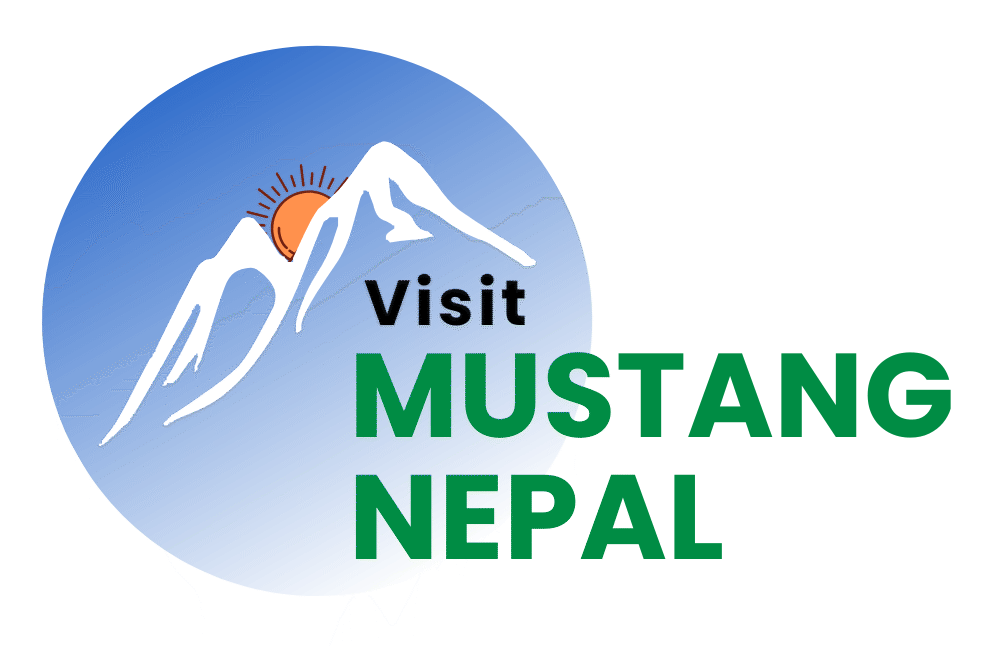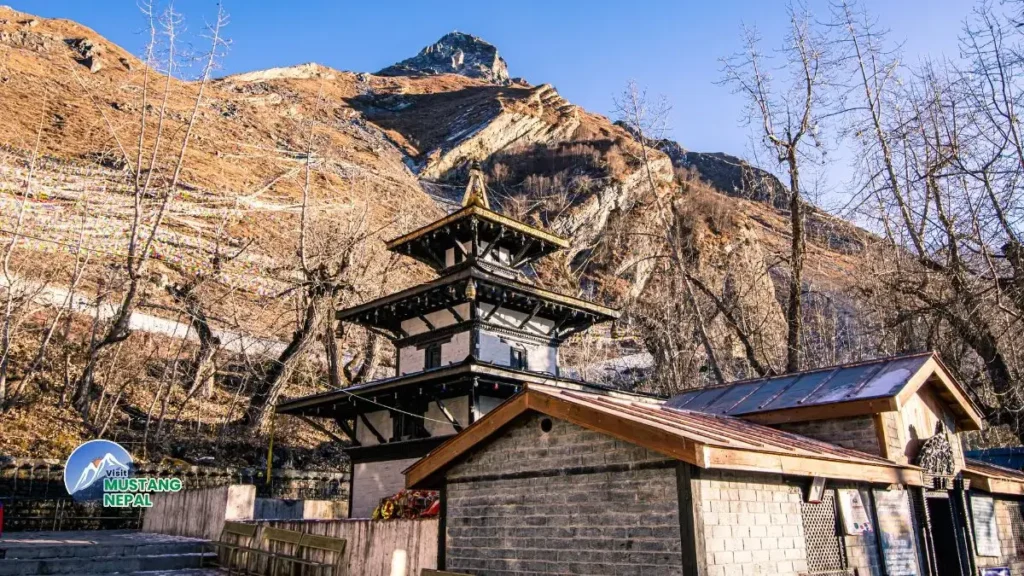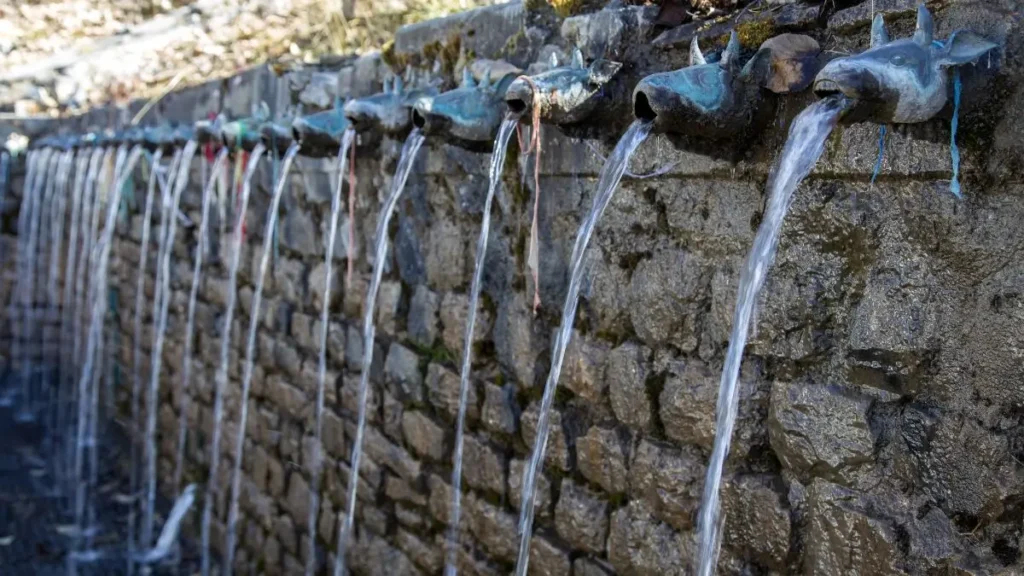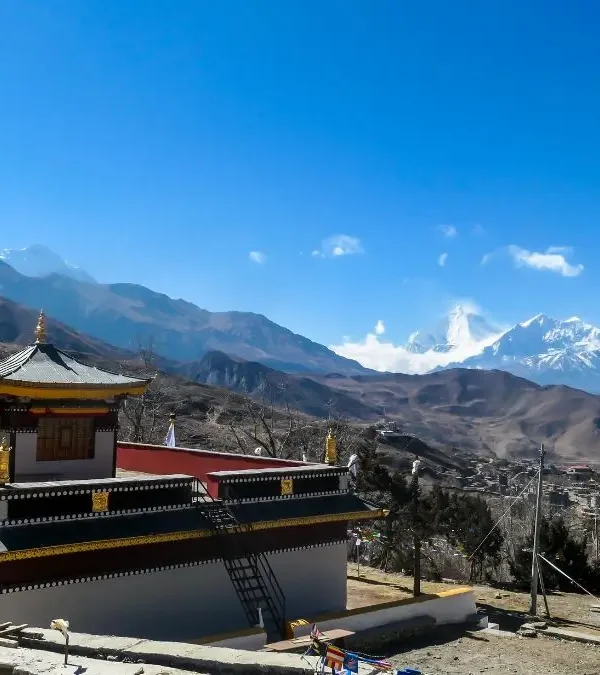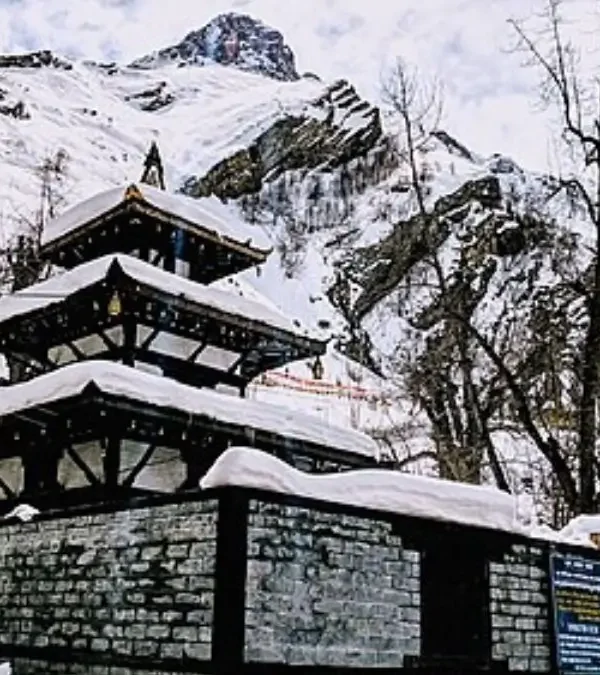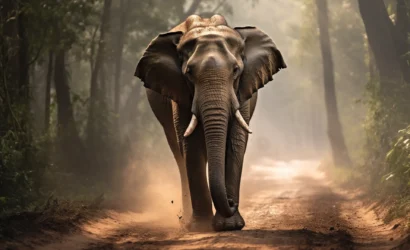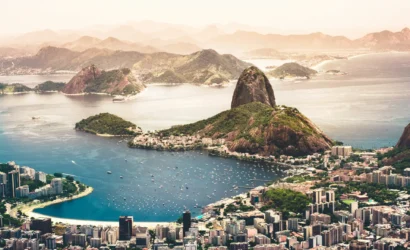Muktinath is an ancient temple revered by both Hindus and Buddhists. It is known as the “Lord of Liberation.” This temple is dedicated to Lord Vishnu for Hindus and Avalokitesvara for Buddhists. This temple symbolizes a unique harmony between the two faiths. Its altitude is 3800 meters.
Overview
The temple is one of the 108 Divya Desams of Hinduism. The only one outside India. It is also ranked among the eight Svayam Vyakta Ksetras and 51 Shakta Pithas. For Buddhists, Muktinath, or Chumig Gyatsa (“Hundred Waters”). It is associated with dakinis, or Sky Dancers, making it a sacred Tantric site.
The peaceful, less-traveled path across Mustang’s dry, desert-like terrain is what distinguishes the Muktinath journey. You will experience a blend of spiritual exploration and beautiful Himalayan scenery, winding through high mountain passes, lush valleys, and remote villages. You will also experience both the cultural richness and natural beauty of this sacred region.
Highlights
- Hike around the Kali Gandaki Valley. It is also known as Andha Galchi. It is among the most profound gorges on the globe.
- Go on a pilgrimage to the holy Muktinath Temple. Both Hindus and Buddhists worship this temple.
- Explore charming villages like Kagbeni, Marpha, and Ranipauwa, where time seems to have stopped.
- Witness the snow-capped Himalayan peaks that surround you at every turn.
- Experience the Tibetan culture and Thakali traditions, from local architecture to cuisine.
Includes/Excludes
Cost Includes
- Experienced guides and porters who assist you throughout the Muktinath Trek.
- Accommodation in local teahouses or lodges along the route.
- Meals during trekking days are often breakfast, lunch, and dinner.
- Trekking permits such as the Annapurna Conservation Area Permit (ACAP) and Trekkers’ Information Management System (TIMS) card.
- Transfers between airports and hotels at the starting and ending points of the trek.
Cost Excludes
- Personal travel insurance is highly recommended for the Muktinath Trek.
- Domestic flights to and from Jomsom or Pokhara.
- Personal expenses such as snacks, drinks, laundry, and souvenirs.
- Tips for guides and porters are customary but optional.
- Trekking gear rental (if needed).
Itinerary
You will arrive in Pokhara. It is the city of Nepal’s lakeside and gateway to the Annapurna region. Today- Relaxing, acclimatization, and preparation for your trek. You can stroll along Phewa Lake, enjoy the stunning Himalayan views, and get your trekking gear ready. Your guide will brief you on the journey ahead, including safety tips, permits, and the best spots for photography. This is the perfect start to your Muktinath trek adventure.
Early in the morning, you will take a short but scenic flight from Pokhara to Jomsom. During the flight, you will see the beautiful views of the Annapurna and Dhaulagiri ranges. If you prefer a jeep ride, enjoy the dramatic landscapes along the Kali Gandaki Valley. Arrival in Jomsom: after arriving at Jomsom, you will check out the local bazaar, get ready for the trek, and observe the contrast between the dry Mustang landscape and the green Pokhara valley. This path preconditions the spiritual and scenic odyssey that is going to follow.
This is the beginning of the day of your trek. In Jomsom, you will trek to Kagbeni. It is a Tibetan mixed village with a historical background. The trek will be through the Kali Gandaki River along barren cliffs and terraced fields. You will see and marvel at the old monasteries and the prayer wheels, meet the local inhabitant villagers, and absorb the tranquil ambiance. Kagbeni is the entry port into Upper Mustang and the cultural epicenter of the trek.
Trekking from Kagbeni to Marpha, you’ll witness the unique Mustang landscapes, dotted with apricot and apple orchards. Marpha is known as the “apple capital” of Nepal, and you can taste freshly pressed apple juice and local sweets. The village also features traditional Tibetan architecture, monasteries, and narrow cobbled streets. This day is a blend of cultural immersion and moderate trekking, offering plenty of photo opportunities along the trail.
You will trek to Ranipauwa from Marpha. It passes by picturesque villages, harsh mountains, and dry valleys. You will get the marvelous views of the neighboring mountain peaks in the Himalaya, and also the views of the Kali Gandaki River. On the way, you will get to the view of the local farm, monasteries, and the stone walls of Mani marking the path. Ranipauwa is a relaxing halt just prior to reaching the top of Muktinath. Here you may rest and acclimatise.
You will trek to the sacred Muktinath Temple. It is famous for its 108 holy water spouts and eternal flame. You will feel a religious vibe. That is where you can spend time discovering the temple complex, communicating with monks, and taking in wonderful views of the neighboring mountains. You can either spend some time and stay in Muktinath or go back to Ranipauwa after a satisfying visit.
On the return journey, you can trek back to Jomsom, or you can also take the helicopter ride option for a spectacular aerial view of the Mustang landscapes. This day is more relaxed, and you will reflect on the trek. You will revisit favorite spots and capture final photos of the Himalaya. Jomsom offers amenities for rest, shopping, and cultural exploration before departure.
Your adventure concludes with a flight or jeep ride back to Pokhara. You can use this day to relax, shop for souvenirs, and enjoy a farewell meal in the lakeside city. You can take one last look at the Annapurna and Dhaulagiri ranges before returning home or continuing your Nepal journey. This final day wraps up an unforgettable spiritual and scenic Muktinath trek experience.
Muktinath
Trekkers Information
Spiritual Significance
Muktinath Trek has spiritual importance due to the fact that it ends at the sacred temple of Muktinath. It is a holy pilgrimage point of Buddhists and Hindus alike, where pilgrims seek blessings at the 108 holy water spouts and the eternal flame.
You will experience the combination of natural beauty and spiritual rituals, which creates a unique, soul-enriching experience.
- The temple symbolises purity and liberation. It offers spiritual cleansing to visitors.
- Pilgrims perform rituals and prayers that have been practised for centuries.
- You will experience the peaceful moments of reflection amidst the majestic Himalayas.
- Interacting with monks and locals offers insight into Tibetan Buddhist and Hindu practices.
Muktinath Trek Difficulty
The Muktinath Trek is considered easy to moderate, suitable for you, whether you are a beginner or have some trekking experience.
Trails are generally well-marked, though some sections can be rocky or steep.
- You have to trek 4 to 6 hours daily, allowing a comfortable pace.
- The trek provides gradual altitude gain, helping you acclimatise safely.
- Suitable for anyone who enjoys scenic trekking without extreme challenges.
Fitness Level
A basic to moderate level of fitness is recommended for the Muktinath Trek.
- You will need endurance for daily walks of 4–6 hours.
- Gradual altitude gains up to 3,710 meters ensure safe acclimatisation.
- You must have light preparation, such as daily walks, stair climbing, and cardio exercises.
- We will provide support, ensuring you feel confident throughout the trek.
Accommodation and Tea Houses at Muktinath Trek
Staying along the Muktinath Trek offers a mix of comfort and cultural immersion. You will vacation there, sleep and rest, and experience local hospitality after your day’s trek.
Accommodation:
- In large villages like Kagbeni, Marpha, and Ranipauwa, there are lodges and guesthouses.
- There are differing options, whether one is on relatively low and medium categories or at the high end.
- Well-rested beds, fresh linens, and simple facilities are available.
Tea Houses:
- Along the trekking path, there are hosting stations offering hot drinks, warm dishes, and rooms amongst the tea houses.
- They will be perfect to communicate with local people and other travellers, gaining a cultural experience.
- There is also Wi-Fi connectivity, charging points, and small shops selling trekking necessities provided in most of the tea houses
Best Time to Go on the Muktinath Trek
The Muktinath Trek is best enjoyed during spring and autumn when the weather is most stable and the views are crystal clear.
- Spring (March to May): Spring is another great time to undertake the Muktinath Trek as rhododendrons are in full blossom during this time, and the temperatures are not too hot. The views of the Himalayas are improved by the clear skies.
- Autumn (September to November): Autumn offers crisp air and excellent visibility. The Muktinath Trek during this season provides stunning panoramic views of the surrounding peaks and comfortable trekking weather.
- Monsoon Season (June to August): This is not an ideal time for the Muktinath Trek due to heavy rains and landslides in lower regions, although Mustang itself is in the rain shadow and receives less rain.
- Winter: Cold temperatures and snow make trekking challenging but still possible for experienced trekkers on the Muktinath Trek.
Permits and Regulations For Muktinath Trek
To trek the Muktinath route, you must have the proper permits, ensuring your journey is legal and well-regulated.
TIMS Card (Trekking Information Management System)
The TIMS card is mandatory for all trekkers and ensures your safety is monitored during the journey. It also helps authorities manage trekking routes and emergencies efficiently. You can obtain the TIMS card at the Nepal Tourism Board offices in Kathmandu or Pokhara, or through your trekking agency before departure.
Annapurna Conservation Area Permit (ACAP)
Before entering the Annapurna Conservation Area, ACAP must secure the natural and cultural assets in the area. It is valid throughout the time you are trekking and assists in the sustainable tourism programs. An ACAP permit can be obtained at the Southeast Asia offices of the ACAP in Kathmandu, Pokhara, or at entry points to the conservation area.
Permitting is prepared by us, so you can concentrate on trekking without administrative anxieties. Always bring your validated identification together with the permits to be checked at checkpoints.
Who Should Attempt the Muktinath Trek?
The Muktinath Trek suits various types of travellers:
- Spiritual seekers wanting to visit the sacred Muktinath Temple and experience Himalayan religious traditions.
- Moderate to experienced trekkers who can handle altitude changes and rugged terrain.
- Adventure travellers are looking for less crowded, off-the-beaten-path trails.
- Photographers and nature lovers were interested in unique landscapes and cultural scenes.
- Families with older children who have some trekking experience.
What to Pack for Your Muktinath Trek?
Packing smart is one of the keys to having a comfortable and successful Muktinath Trek. Having the appropriate equipment will keep you safe and content on the path because the weather and terrain change throughout the trip. Here is a comprehensive list of things you must bring:
Clothing
- Warm Layered Clothing: Temperatures can drop drastically at higher altitudes, mostly in the early morning and evening. You must pack thermal base layers, fleece jackets, a down jacket, and moisture-wicking shirts.
- Waterproof Jacket and Pants: Sudden rain or snow is possible, so having waterproof outerwear is essential.
- Trekking Pants and Shirts: Lightweight and quick-dry materials are best for daytime trekking.
- Hat, Gloves, and Scarf: To protect against cold winds and chilly mornings.
- Sun Hat and Sunglasses: The sun is intense at high altitudes, so bring a wide-brimmed hat and UV-protective sunglasses.
Footwear
- Sturdy Trekking Boots: Make sure they’re broken in and provide good ankle support for rocky and uneven paths.
- Comfortable Trekking Socks: Wool or synthetic socks help prevent blisters and keep your feet dry.
Gear and Accessories
- Backpack (30-40 litres): Big enough for day essentials but light enough to carry comfortably.
- Sleeping Bag: If your package accommodation doesn’t provide one, bring a warm sleeping bag rated for cold temperatures.
- Trekking Poles: Great for reducing strain on your knees during steep descents and long hikes.
- Water Bottle or Hydration Bladder: Staying hydrated is important, so you must bring something easy to carry and refill.
- Water Purification Tablets or Filter: Tap water isn’t always safe, so purifying water is a must.
- Headlamp or Flashlight: Useful for early starts or power outages.
- Power Bank: To keep your devices charged on the go.
Health and Safety
- Basic First Aid Kit: Include altitude sickness medication, painkillers, bandages, blister treatment, and any personal medicines.
- Sunscreen and Lip Balm: High SPF is important to protect your skin from strong UV rays.
- Hand Sanitiser and Wet Wipes: Carry these for your own hygiene on the trail.
- Toiletries: Bring biodegradable soap, a toothbrush, and other personal items.
Other Tips
- Pack Light: Try to keep your backpack weight under 10-12 kg to make trekking easier.
- Dress in Layers: You must dress in layers so that you can adjust your clothing easily to changing weather conditions.
- Check Your Package Details: Some packages provide certain gear or meals, so pack accordingly to avoid duplicates.
How Safe Is the Muktinath Trek?
The Muktinath Trek is generally considered safe for most trekkers, but like any high-altitude adventure, it requires proper preparation and awareness.
- Altitude Sickness: Since the trek reaches nearly 4,000 meters, altitude sickness is a real risk. It’s essential to take your time to acclimate properly and listen to your body. Don’t rush the ascent, and stay hydrated.
- Unpredictable Weather: The weather in Muktinath can change quickly. You must be prepared for freezing temperatures, strong winds, and sudden storms, particularly at higher elevations.
- Guides Enhance Safety: It is highly recommended that you hire an experienced local guide. They not only provide you with valuable knowledge about the terrain and weather but can also assist quickly if any emergencies arise.
- Emergency Evacuation: In case of serious illness or injury, helicopter evacuation is available. It is mainly from Jomsom. However, this can be expensive, so having travel insurance that covers such emergencies is wise.
Altitude Sickness: Prevention and Treatment on the Trek
Altitude sickness can affect anyone on the Muktinath Trek due to the rapid ascent. Symptoms entail headaches, dizziness, nausea, and shortness of breath. Prevent it by climbing gradually, drinking lots of fluids and taking acclimatisation days.
In case of a deterioration of the symptoms, go down and consult a doctor. Altitude sickness is common on the Muktinath Trek, and thus, individuals who are susceptible to altitude-related illness must carry items like acetazolamide and oxygen cylinders.
Booking, Cancellation, and Weather Policies – Visit Mustang Nepal Travel Agency
How to Book:
- Book your Mustang trek easily through Visit Mustang Nepal Travel Agency.
- We take care of permits, transport, lodging, and qualified guides so you have a stress-free experience.
- To get a personalised element, it is also possible to book directly with our long-time locals in Pokhara or Jomsom.
- We recommend booking at least two to four weeks before a trek, especially in peak trekking periods.
Flexible Cancellation & Rescheduling Policies:
- In case of emergency, we do not want money and provide free cancellation with appropriate evidence (health problems, natural disaster, etc.).
- Weather or travel disruptions do not carry any additional cost, as the rescheduling is free.
- Refunds are made within the range of 7-10 working days, and partial refunds are made in case the permits or transport that cannot be refunded have already been used.
Travel Insurance Advice:
We strongly advise getting travel insurance that includes the following coverage:
- Trekking (High altitude, up to 4,000 meters)
- Medical Evacuation, Emergency.
- Loss of luggage and cancellation of the journey.
- We are dealing with good insurance.
Ready to explore the breathtaking beauty of Muktinath? Don’t wait! Secure your spot with Visit Mustang Nepal today for a seamless and unforgettable trekking experience. Our expert team is here to guide you every step of the way. Book Now!!
FAQs
Yes, upon reaching the summit, the trek elevation reaches as high as 3,800 meters; therefore, there are chances of some trekkers getting affected by mild altitude sickness. To minimize risks, acclimatization should be maintained, hydration should be maintained, and a constant pace should be maintained.
Not always. Although some hiking experience is helpful, the walk is appropriate for people who are moderately fit. It is advised to perform aerobic and endurance workouts prior to training.
Although one can do it independently, a guide is encouraged as to stay safe, navigate, and learn about the culture and help one with various logistical needs.
Yes, it can be combined with parts of the Annapurna Circuit or extended to explore Upper Mustang, depending on your time and permits.
Always greet with “Namaste,” ask before taking photos of locals, dress modestly near temples, and walk clockwise around religious monuments.
Mobile coverage is available in major villages like Jomsom and Kagbeni. Some tea houses offer Wi-Fi, but the connection can be slow or unreliable.
Both a TIMS card and an Annapurna Conservation Area Permit (ACAP) are required. These can be organized by your hiking agency in Kathmandu or Pokhara.
Tibetan bread, soups, noodles, and dal bhat (rice and lentils) are common dishes. There are plenty of vegetarian options, and tea houses serve freshly made cuisine.
